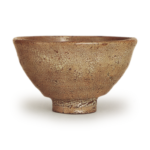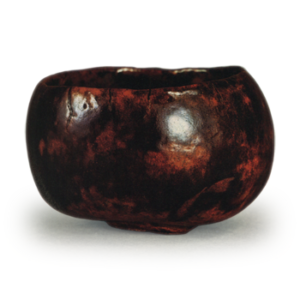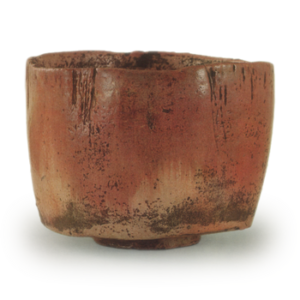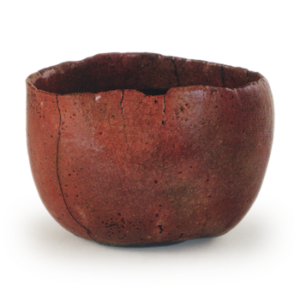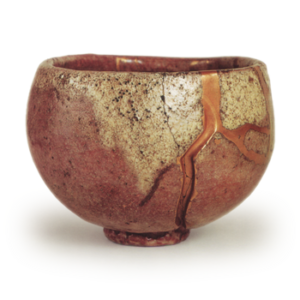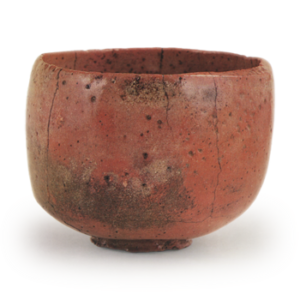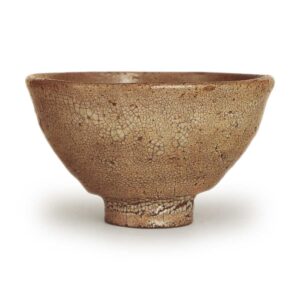
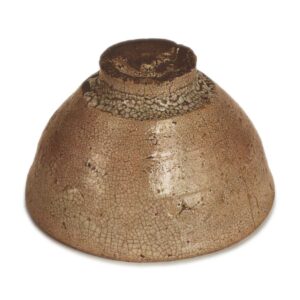
Daimyo-mono
Held in the collection of the Tokyo National Museum
Height: 9.0cm
Diameter: 15.1cm
Outer diameter of foot ring: 5.6cm
Height of foot ring: 1.6cm
The Uraku well, named after Oda Urakusai, who once owned it, is said to be the fourth most famous large tea bowl after the Kizaemon, Tsutsui-tsutsumi and Hosokawa, but while the Hosokawa is elegant, this is a tea bowl with a subdued, dignified feel. It is often described as having the appearance of a wild warrior, and while it does have that kind of atmosphere, it is by no means low-class, and has a considerable sense of mass.
The kasuyaku glaze that covers the entire piece is not the bright loquat-colored glaze of the Tsutsui-tsubo or Hosokawa, but rather a somber color with a hint of grayish brown, which is probably why it is described in this way.
The shape is quite elegant, with a truly straightforward rise from the foot to the rim, and the upper part of the body is slightly bulging, with the rim slightly curved outwards. The overall thickness is a little thick, so it feels heavy for its shape.
The kaeragi (the pattern of the raised rim) is finely detailed at the rim, and changes to a sharper pattern at the foot of the rim, giving it a rich flavor.
There are four eye marks on the inside, and the center is concave. This is not a showy tea bowl, but it has a calm, subdued flavor, like tarnished silver. can be said to be a famous bowl that is truly worthy of being owned by Urakusai.
The Urakutei Chayu Nikki (Urakutei Tea Ceremony Diary) records that this bowl was used at a tea ceremony in the following way in 1612.
June 16th, 1612, tea ceremony at noon: Host: Oda Uraku, Guests: Nagano Uraku, Ohori Samasuke, Saji Yokuro
Hanging scroll: “Four Sleepers
Vase: Kyoto, white lotus vase
Tea caddy: Tamagaki Bunchin, on an inner red tray
Tea bowl: Ido tea bowl
It is thought that the hanging scroll on the floor was a ‘Four Sleepers’ painting by Bakkei, which later passed into the Mito Tokugawa family.
It is not clear how the scroll came to be in the possession of the Kunikuniya Bunzaemon family after the death of Urakusai, but it is said that it later became the property of Kunikuniya Bunzaemon, and that it is mentioned in the book “Kokin Meibutsu Ruiju” as “Uraku Ido Kunikuniya Bunzaemon”. It is also said that the gold and silver powder writing of “Uraku Ido” on the back of the box lid was written by Ichiyo. It was passed on from one person to another, and at the end of the Edo period it was owned by Senba Taroemon of Edo, and then by Ijuin Kanetune of Satsuma, before ending up in the possession of Fujita Hikosaburo of Osaka at the start of the Meiji era. When the Fujita family put it up for auction, it was purchased by Matsunaga Yasuzaemon, who donated it to the Tokyo National Museum in 1950.
The bag is made of silver brocade with a design of cranes and clouds in gradated colors, and the inner box bag is made of silk with a design of loofahs in gradated colors. It is thought that the bag for the box was made by the Fujita family.

